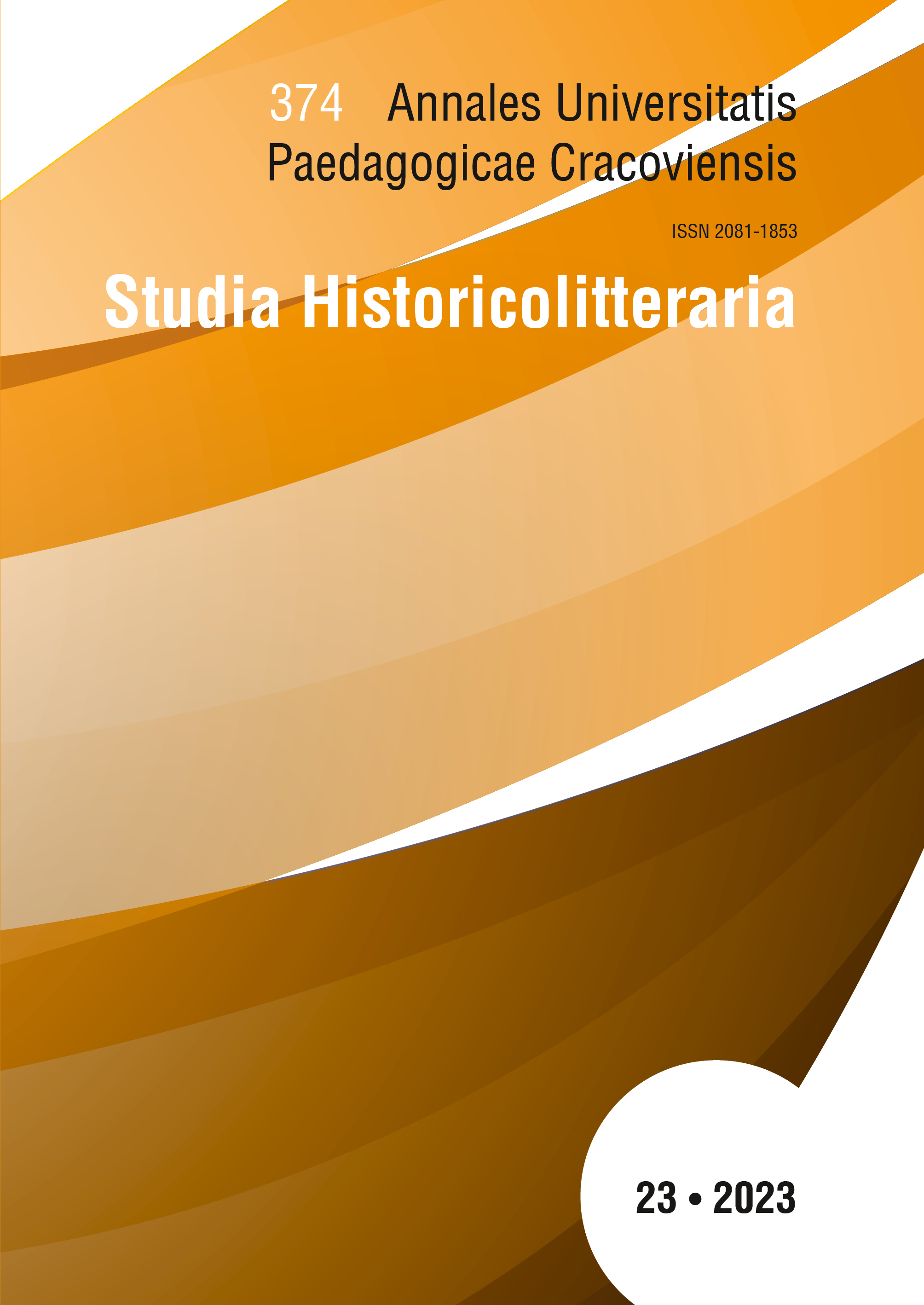The Memory of the Great War in two books for children – Polish and English perspectives
Hauptsächlicher Artikelinhalt
Abstract
Two books for children about the Great War will be discussed: Bohaterski miś [Heroic teddy bear] by Bronisława Ostrowska and Five Children on the Western Front by Kate Saunders. It will be a comparative analysis. The books differ in terms of national perspective (Polish and English), but also in the time of edition – just after the war and a hundred years later. Thus, Ostrowska’s memory about the war is her own memory, whereas Saunders’ writing can be called a postmemory narrative. The aim of the paper is to answer the questions: what is similar and what is different in the two selected children’s novels about the Great War? What are the ways of transmitting memory? What do the writers want to save for new generations?
Downloads
Artikel-Details

Dieses Werk steht unter der Lizenz Creative Commons Namensnennung - Nicht-kommerziell - Keine Bearbeitungen 4.0 International.
URHEBERRECHTE
Der Herausgeber der „AnnalesUniversitatisPaedagogicaeCracoviensis. StudiaHistoricolitteraria” ist zur Nutzung und Verbreitung aller in der Zeitschriftveröffentlichten Materialien auf Grundlage eines nicht ausschließlichen, zeitlich unbeschränkten Lizenzvertrags befugt, der im Voraus unbefristet mit jedem/r Autor/in des jeweiligen Werks für die im betreffenden Vertrag vereinbarten Nutzungsbereiche abgeschlossen wird.
POLITIK DES OFFENEN ZUGRIFFS
Die „AnnalesUniversitatisPaedagogicaeCracoviensis. StudiaHistoricolitteraria” sind eine Fachzeitschrift mit freiem Zugriff, dessen voller Inhalt kostenlos für Nutzer und Einrichtungen auf Grundlage einer nicht ausschließlichenCreativeCommons-Lizenz (CC BY-NC-ND 4.0) verfügbar ist. Die Nutzer/innen können die Artikel in dieser Zeitschriftohne vorherige Zustimmung des Herausgebers oder des/r Autors/in lesen, herunterladen, Kopien anfertigen, verbreiten, drucken oder zu Volltexten verlinken, insofern die Quelle des Zugriffs und der/die Autor/inder jeweiligen Publikation angegeben wird. Dies ist mit der BOAI-Definition des offenen Zugriffs konform (http://www.soros.org/openaccess).
Literaturhinweise
Białek J.Z., Literatura dla dzieci i młodzieży w latach 1918–1939. Zarys monograficzny. Materiały, Warszawa 1979.
Bradman T., Tony Bradman’s 10 top books about the first world war, https://www.theguardian.com/childrens-books-site/2014/jul/03/top-ten-childrens-books-first-world-war [access: 4.04.2023].
Craig A., Kate Saunders Obituary, “The Guardian”, 24 April 2023, https://www.theguardian.com/books/2023/apr/24/kate-saunders-obituary [access: 14.07.2023].
Czermińska M., Places of Autobiography: A Geopoetic Proposition, [in:] From Modern Theory to a Poetics of Experience. Polish Studies in Literary History and Theory, eds. G. Grochowski, R. Nycz, Frankfurt am Main 2014, pp. 253–270.
Graban-Pomirska M., Szkoła narzeczonych. O powieści dla dziewcząt w dwudziestoleciu międzywojennym, Gdańsk 2008.
Hirsch M., Family Frames. Photography, Narrative and Postmemory, Cambridge, MA – London 2012.
Kuchta A., Wobec postpamięci, Kraków 2020.
Michułka D., Świetlicki M., García-González M., Theory and Practice of Memory in Culture of the Present from the Perspective of Research on Literature for Young Readers, “Filoteknos” 2021, vol. 11, pp. 12–21.
Nadolna M., Powrót książek zakazanych dla młodego odbiorcy po transformacji ustrojowej w latach dziewięćdziesiątych, [in:] Literatura dla dzieci i młodzieży (po roku 1980), vol. 2, ed. K. Heska-Kwaśniewicz, Katowice 2009, pp. 109–118.
Nora P., Between Memory and History: Les Lieux de Memoire (1989), transl. by M. Roudebush, https:/courseworks2.columbia.edu [access: 14.07.2023].
Nora P., Między pamięcią a historią, transl. J.M. Kłoczowski, Gdańsk 2022.
Olech B., Dziecięce odkrywanie świata wojny. “Bohaterski miś” Bronisławy Ostrowskiej i “Dzieci Lwowa” Heleny Zakrzewskiej, [in:] Pierwsza wojna światowa w literaturze polskiej i obcej. Wybrane zagadnienia, eds. E. Łoch, K. Stępnik, Lublin 1999, pp. 217–225.
Olech B., Narodowe legendarium – o liryce okolicznościowej Bronisławy Ostrowskiej, [in:] Literatura wobec I wojny światowej, eds. M.J. Olszewska, J. Zacharska, Warszawa 2000, pp. 89–108.
Olech B., Harmonia, liryzm, trwoga. Studia o twórczości Bronisławy Ostrowskiej, Białystok 2012.
Rybicka E., Place, Memory, Literature (from the perspective of geopoetics), “Teksty Drugie" 2012, no. 2, pp. 126–139.
Węgrodzka J., Patterns of Enchantment: E. Nesbit and the traditions of children’s literature, Gdańsk 2007.
What are the best first world war books for children?, https://www.theguardian.com/childrens-books-site/2014/jun/30/best-first-world-war-ww1-books-for-children-and-teens [access: 4.04.2023].
Wójcik-Dudek M., Reading (in) the Holocaust. Practices of Postmemory in Recent Polish Literature for Children and Young Adults, transl. P. Poniatowska, Berlin 2020.
Wydrycka A., Poetka „wielkiej jedności”, [in:] B. Ostrowska, Poezje wybrane, ed. A. Wydrycka, Kraków 1999, pp. 5–39.
Wydrycka A., „Drogi promienia”. O biografii i opowiadaniach wspomnieniowych Bronisławy Ostrowskiej, „Wiek XIX. Rocznik Towarzystwa Literackiego im. A. Mickiewicza” 2009, pp. 106–127.
